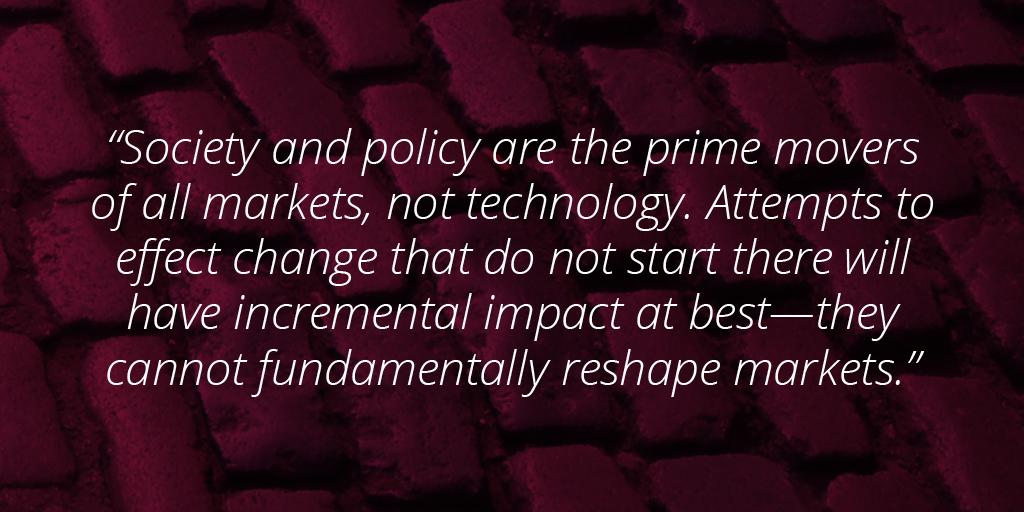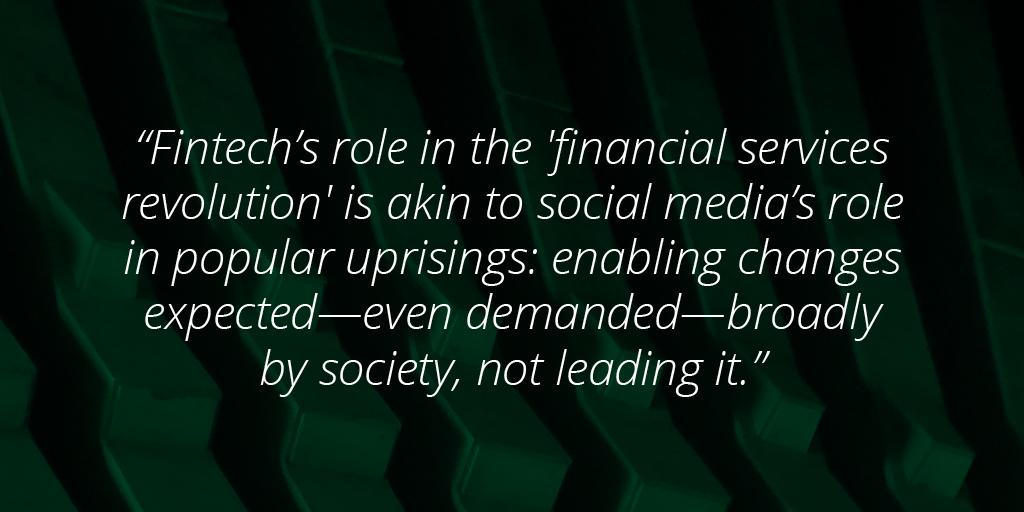
Is FinTech a Threat to Financial Orthodoxy?
The perfect storm: incumbents in publishing, media, entertainment, and retail have been displaced by unencumbered upstarts, who have reshaped the competitive landscape in their own image. In the wake of the 2008 crisis, financial institutions (FIs) were weakened by new regulations and a loss of public confidence.
Financial services looked like it would be next for technological reinvention. Armed with optimism and nearly $50b, venture capital firms went on a multi-year campaign to disrupt, transform, and otherwise fix financial services with apps, service model designs, and tail strategies no large financial institution could hope to replicate.
The landscape filled up fast with new means of lending, cheaper forms of wealth management, and even entirely new currencies. Regulators fanned the flames by making it easier for innovators to go to market and endorsing the promises of fledgling tech.
With so much hype, it was no longer a question of merely challenging the incumbents. Fintech was going to rewrite financial orthodoxy itself, fundamentally reshaping capital markets and even the economic principles on which they’ve functioned since the dawn of time.

Orthodoxy Strikes Back
What the narrative didn’t take into account is that financial services are messier than the “efficient” models they’re based on. For many institutions, the unspoken truth is that they only survive at the razor’s edge. They must be able navigate complex market inefficiencies and business cycles.
Society and policy are the prime movers of all markets, not technology. Attempts to effect change that do not start there will have incremental impact at best—they cannot fundamentally reshape markets.
Would-be Disruptors Stumble Over Capital Markets, Not Incumbents
| Category | Old-School Problem | Orthodox Solution |
| Lending | Not immune to credit cycles |
Pitch the product to the deep-pocketed institutions we were out to disrupt: sell loan portfolios to banks
Create a buyer of last resort: change the business model from moving to moving and storage Deposit insurance: offer par protection to lenders |
| Property Crowdfunding | Asset bubbles and price volatility stemming from limited liquidity | Reduce supply: cut supply of new assets to boost secondary trading |
| Cryptocurrency trading | Not much money to be made as a pass-through exchange | Lever up the balance sheet like mainstream broker/dealers: process customer trading from your own balance sheet, keeping deposits in cold storage |
| The exchange was robbed |
The optimistic interpretation: Equity bail-in: just as bank equity is loss absorbing capital, make the wallet deposits loss-absorbing capital
The pessimistic interpretation: Make the firm whole by covering the loss out of segregated accounts: just as MF Global (illegally) covered trades out of customer accounts, the exchange is unregulated and therefore free to make itself whole at the expense of uninsured depositors |
|
| Client capital lost legitimately, but in a way nobody foresaw—and in a spectacular fashion to boot | Roll-back the trades and pretend it never happened: just as the NYSE suspends trading and rolls back in the event of a flash crash, mute the immutable ledger and roll-back | |
| Robo-advisors | Competitive response from mainstream brokers pushes break-even far into the future, and investment capital won’t last that long | Consolidation: enter into an expensive arms race and race-to-the-bottom pricing war to win market share and hope to become large enough to be an acquirer or acquired, just like early 20th-century industrial firms |
What’s become obvious is that fintech firms are at the mercy of the very same market forces affecting established FIs. No FI can get by for very long if it competes primarily on regulatory arbitrage, loses competitiveness when the business cycle changes, operates marketplaces without a buyer of last resort, or relies on constant capital injections to stay afloat pursuing scale in race-to-the-bottom pricing.
No wonder fintech firms are starting to look more “fin” than “tech”: they’re running into the same macroeconomic forces as their institutionalized forebears did. And they’re reaching the same conclusions on how to navigate those forces, only without the deep balance sheets or financial expertise of their incumbent competitors.
This isn't "challenging orthodoxy". This is caving in to orthodoxy.
Does Fintech Still Promise a New Financial Orthodoxy?
To some extent, this is the normal shake-out of an industry experiencing creative destruction. Once past this stage, does fintech still promise a new world order of finance? After all, consumers now expect one that is intermediary-free, smart-contract driven, crypto-currency denominated and real-time regulated, with equity and transparency for all.

Before we can find out, there are enormous challenges to overcome, challenges that aren’t fintech in nature. Two big ones: the lack of trust in a digital counterpart, which makes it all too easy to thwart Asset Money Laundering and Know Your Customer (AML/KYC) laws, or the inherent volatility and illiquidity of an intermediary-free exchange mechanism.
Initial applications of blockchain-based smart contracts reveal that they are fragile and currently unsuitable for commercial use. Questions remain regarding trans-jurisdictional consistency and enforcement of contract law, the legal status and outworking of smart contracts and organizations based upon them. There is currently zero regulatory oversight for consumer protection, and even concerns regarding the soundness of the fundamental technologies underpinning smart contracts. Without resolving these issues, smart contracts remain a nascent technology lacking the legal, regulatory and business policy frameworks needed for commerce.
As we’ve written before, these aren't trivial problems. Initial solutions will likely be accompanied by unknown and potentially severe unintended consequences.
The longer it takes for fintech to realize its potential, the less likely the optimistic future forecast today is an accurate portrayal of tomorrow. Societal, political and institutional headwinds are sure to buffet policy makers in unpredictable ways.
Meanwhile, centuries of expectations and decades of incumbency aren’t going to immediately succumb to businesses cultivated in finserv petri dishes, shielded from regulatory demands that have weak immune systems to chronic financial diseases like sustainable liquidity and credit cycles.
Driven by intense competition, evolving regulations and navigating market ebbs and flows, FIs have always been at the leading edge of technology adoption. Yet while fintech won’t reshape financial services by itself, it can catalyze leaders to explore new capabilities more quickly and pushing its usage closer to clients.
But don’t be mistaken: tech isn’t leading this revolution. Fintech’s role in the “financial services revolution” is akin to social media’s role in popular uprisings: enabling changes expected—even demanded—broadly by society, not leading it.
In Part II, we’ll look at what a new financial orthodoxy would really look like.
Disclaimer: The statements and opinions expressed in this article are those of the author(s) and do not necessarily reflect the positions of Thoughtworks.














